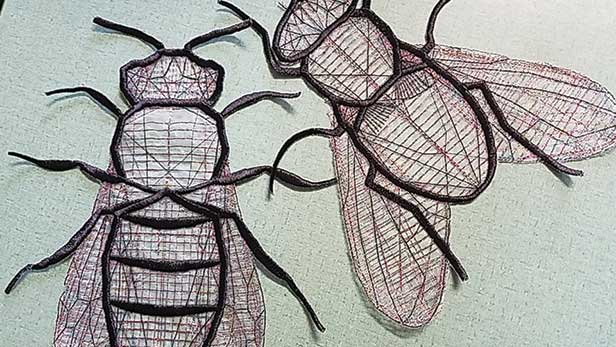Strategy September 11, 2019
How To Decorate On Delicate Fabrics
I’ve been an embroiderer for a long time, but it’s only in the last couple of years that I finally broke through my fear of embroidering on sheer fabric.
Inspiration came when I took a once-in-a-lifetime trip to visit my favorite digitizer, Vitor Mendes, owner of Brazil-based Vitordigitizing. His shop was hung with beautiful embroidered lace window treatments, and after I admired them, Vitor’s wife, Cris, took me to the largest fabric store I’ve ever seen, filled with delicate, sheer fabrics on bolts and sold by the yard.

These delicate insects, embroidered on sheer organza, were later affixed to an upholstered chair.
After the trip, I started to practice stitching on sheer materials. Soon after, one of my customers commissioned me to make some embroidered bugs for his upholstered chairs. The bugs had to be created separately and attached to the chairs, because it would have been too difficult to remove the upholstery, and the client was too in love with the chair fabric to reupholster them.
Here’s the method I used to complete this delicate work. (The good news is if you’re already embroidering on thin T-shirt fabrics or very fine sport fabrics, tackling a sheer fabric is a natural transition.)
Note that the right embroidery backing will help keep everything in place and the design true and registered. Backing can be your choice of tearaway, water-soluble topping or wash-away. With sheers, I tend to favor washable backing. However, that means you must be able to soak the project after you finish, so if the embroidery will be attached to a silk dress, you have to be careful or just use a single layer of tearaway backing instead. To remove the excess, hold the design close to the embroidery and gently pull the backing away. You might end up with some light, wispy edges, but they can usually be rubbed away.
Hoop your fabric in the hoop closest to your design size, and make sure the entire project is hooped with the backing of your choice all the way to the edge. Your bobbin should be in the white for light colors and black for darker colors (or if you wind your own, use the same color thread as your design). A 60-weight thread is perfect for fine details, though I just used a standard 40-weight poly for these bugs. The design was digitized for regular embroidery, and then I edited the density down 20% of the fill and 10% on the column. You can request a digitized design for sheer fabric, but if you’re using a regular, purchased embroidery design I recommend editing the density yourself.
After hooping, embroider the design using your standard thin fabric head pressure and a 75 sharp-point needle. (I run an AMAYA XT, so the pressure was all the way down, and I set the speed at 950 spm.) It’s important to watch your tension so the design doesn’t become so tight that it pulls the edges and makes holes inside the text or in small designs. If tension is too loose, the design will look flimsy and looping, and your bobbin thread will show through the top of the design.
Once you embroider, un-hoop the design, and then tear away the backing, keeping your thumb on the design to keep it from tearing away. Or soak your design in water until the entire wash-away is gone and it doesn’t feel sticky. Sometimes, the design will become stiff after drying. If that happens, just re-soak it until it’s light to the touch.
After this, take a piece of cutaway and lay it on top of your design. Use a warm iron to flatten out your images. With the flies, I closely clipped away the sheer fabric left around the edges, then carefully ran my lighter along the edges to melt away the excess fabric and tighten up the column stitch to seal the edge. The end result was a very nice finish, and my client was able to add a liquid thread and hand-sew the flies to the chairs using a curved darning needle.
Carolyn Cagle has been in the embroidery business for 20 years. She ran her own manufacturing company making custom mittens in the U.S. and Canada. For the past decade, she’s focused on embroidering specialty work and custom story coats.
